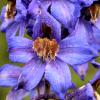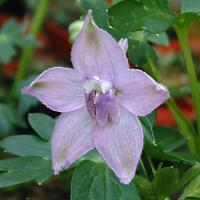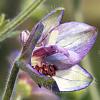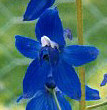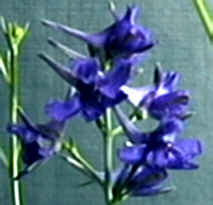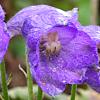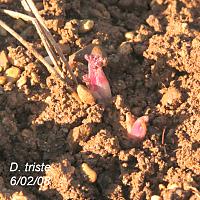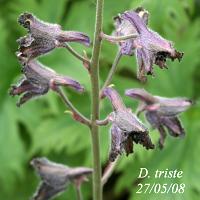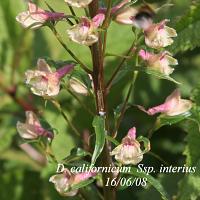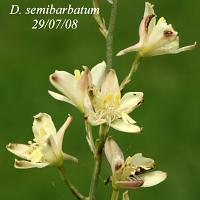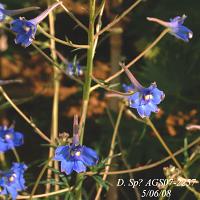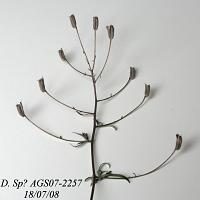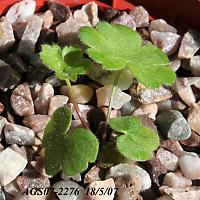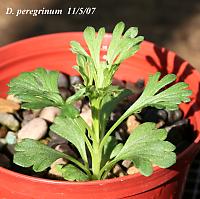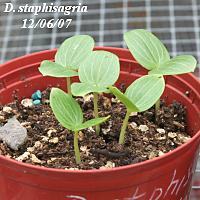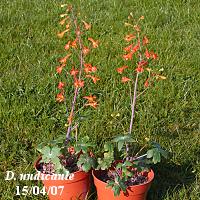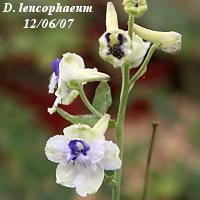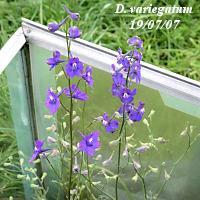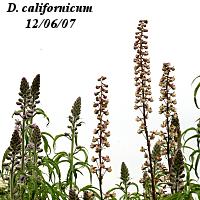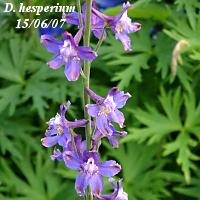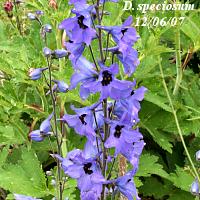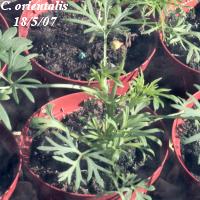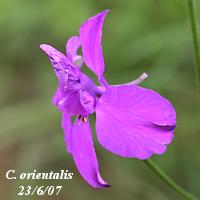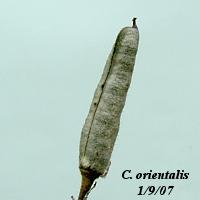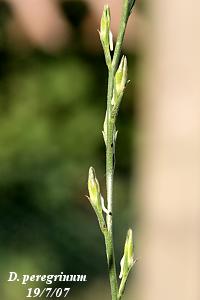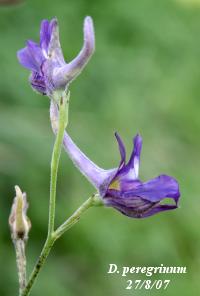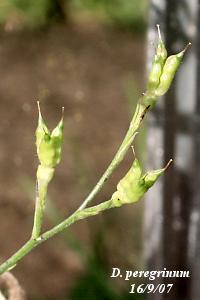| Delphinium
Species in 2008 Cold weather in December 2007with some severe
overnight frosts followed by much warmer conditions in
the new year provided ideal conditions for dormant
delphiniums to start into growth and for seeds to
germinate. The ground around a plant of D.
causcasicum, for example, was liberally dotted with
freshly germinated self-sown seedlings but slugs soon
removed these tasty morsels. Seeds of D. oreophilum sown
last year germinated in the spring but the seedlings have
made very little growth. This species belongs in a
frustrating group which includes some American larkspurs
from desert environments that never seem to develop
beyond the first year seedling stage and it is difficult
to know how to treat them.
It was particularly
pleasing to find that nearly all seedlings of the black-flowered
species, D. triste, survived the winter and grew
flowering stems. The strange and very hairy flowers
opened during late May and June, with a few further stems
of flowers appearing in July. The most disappointing
thing was that seed set was very poor and from ten plants
only two seeds developed to maturity!
Several other
species that have become long term residents in our
borders flowered well during June and July. The Hospital
Canyon Larkspur from California, D. californicum Ssp.
interius had a large mound of foliage in
February and survived severe frosts and the plants went
on to produce several long spikes reaching 2m tall. The
fascinating little flowers are very attractive to bumble
bees and made an interesting foil to the equally curious
flowers of the massive self-sown plants of D.
requienii. Both these delphiniums are prolific seed
producers.
Plants of the yellow-flowered
D. semibarbatum developed flower stems but
weather conditions in June were unfavourable and it
seemed possible that the flowers would never open.
However, after spraying with insecticide to control
spider mites and a fungicide against mildew, the flowers
finally opened in late July after a hot dry spell and are
now having to survive strong winds and heavy rain.
Another delphinium from
sowings of items from the AGS 06/07 list last year, was #2257,
which produced extensively branched dwarf plants that
have intense deep blue flowers with exceptionally long
spurs on very long pedicels. The architecture of the stem
branches is rather unusual with the pedicels emerging
almost at 90 degrees to the stem, as seen in the picture
below. The mature plants have many of these branched
stems with the initial stems growing upright but later
branches spread out almost horizontally to produce an
attractive broad mound of flowers.
The identity of this
species is uncertain. In the AGS List item 2257 was said
to be D. glareosum, a species from western
America that is closely related to D. bicolor.
The germination characteristics were not those I would
expect for these species and the general character of the
plant seems to have more in common with species from Asia.
Further investigation of the identity of this attractive
delphinium is required.
Delphinium
species in 2007
While we already have a
rather large collection of assorted delphinium species in
the ground and in pots of assorted size, there are so
many species of delphinium with interesting features that
the seed lists of the Alpine Garden Society and American
wildflower specialists are an irresistable temptation.
Seeds of two species from the AGS list, D. kumaonense
and D. oreophilum, were tried again because they
have proved unwilling to grow to flower. D.
oreophilum did not germinate but D. kumaonense
germinated during late April. The seedlings have
cotyledons fused to a single stem, as for American
species with tuberous roots and they developed very
little before becoming dormant. An un-identified species,
AGS-2276, has yielded interesting tiny seedlings (seen
below) with very small hairy leaves that suggest they may
originate from a high alpine location.
A number of seedlings
were raised from seed said to be of D. oxysepalum,
which is a dwarf species from the Tatra/West Carpathian
mountains of Poland. The general features of the plants
and the flowers were as expected but one plant had a
clear white eye in the dark blue flowers and another
developed some flowers with 13 sepals (semi-double). This
suggests that these plants were hybrids.
A single seedling of an
annual delphinium from Turkey, D. peregrinum,
was raised from seed received from P. Olsson. This is
interesting in having leaves tapering into the stalk, in
the same way as for the two other European annual species
grown previously. Development and flowering of the plant
is described in more detail below. Plants of D.
triste were raised from seeds from another contact
in Sweden but these showed no sign of flowering. It is
hoped that the plants will survive the coming winter and
produce their black flowers in 2008. From three different
sowings of D. staphisagria, one batch suddenly
produced five dramatically large seedlings, seen on the
right below, after drying out and being then re-wetted by
thunderstorm rain. These developed steadily and began to
flower in early October. It is fascinating to see the
flowers again, ten years after our last success, and it
would be nice to know how to reproduce the sequence of
drying and re-wetting that led to germination.
Species grown in pots
during 2006 were kept dry thoughout the autumn and winter.
Plants of the wild-collected form of D. nudicaule
started into growth very early and flowered well in April.
Most other species remained dry until late April before
pots were wetted to stimulate the dormant root systems
into growth. Unfortunately a fairly high proportion of
the plants produced no growth. Plants of D.
leucophaeum produced only a few flowers. However 8
plants of D. variegatum soon developed new
leaves and flowered well in July, as seen in the right
hand picture below.
Of the wild delphiniums
in our borders, the two plants of D. californicum
s.sp. interius flowered well among a group of
plants of D. requienii. The weather did not suit
D. requienii and the foliage and flowers were
ruined by the heavy rains. Other American species that
flowered well were D. hesperium, (the Western
larkspur seen below) and D. glaucum. Despite
also being known as the 'Tall' or 'Giant' larkspur, the
florets of the form of D. glaucum in our garden
seem tiny and insignificant compared to those of some
Eurasian delphiniums, such as D. speciosum,
which again this year produced a lovely bloom of
beautiful bell flowers, seen below. Another species that
flowered well was D. maackianum, with its
colourful mixture of reddish purple bracts and stems,
greyish hairy leaves and deep violet blue flowers. As
usual, spraying with systemic fungicide was required to
control mildew. The weather conditions did not suit the
yellow flowers of D.semibarbatum but the truly
dwarf plants of D. cashmerianum have seldom been
without a cluster of flowers right through to mid-October.
Perhaps the most
fascinating aspect of the species grown from seed this
year has been comparison of the flowers of a plant
identified at the RHS Garden, Wisley, as Consolida
orientalis with those of the lone seedling of D.
peregrinum. The dissected leaves of the former
suggested that it was an annual larkspur and growing the
plants in pots did not work well since most died after
suffering root loss. However, the pinkish purple colour
of the first flowers was stunning. Taking apart the
components of this annual larkspur flower revealed how it
differs from a delphinium flower. The five large sepals,
with the topmost one having a spur sheathing the nectary,
are similar to those of most true delphiniums. The
nectary is a single unit with forward pointing lobes,
which corresponds to the eye of a delphinium floret that
includes two upper petals with spurs forming the nectary
and another pair of petals or 'honey leaves' that
surround the anthers. The side lobes of the nectary have
a curious ear-like structure and their tips fold across
the anthers. The inner surface of the upper lobes is
streaked with deeper colour. These features presumably
attract and guide pollinating insects and the result of
their activity was that a flower produces a single
seedpod which grows to about 1.5cm in length.
D. peregrinum
is itself also an annual flower but the plant differs
from typical garden delphiniums in several respects. The
first few leaves were like those of D. balcanicum,
another annual species described in Group 1. As the stem
grows and branches, the leaves become reduced to slender
wispy bracts. When the tiny flower buds start to develop,
the almost leafless stems look similar to the flower stem
of a grass as the feathery plumes start to break out. It
is not surprising that one of the common names for this
delphinium is 'Rush larkspur'. The flowers have an upward
pointing spur about 1cm or more long but the forward
pointing sepals and petals are very unusual. The four
purplish-blue lower sepals are cupped to form a spoon in
which the anthers rest and the pair of lower petals are
like inky-blue paddles on thin stalks projecting outwards
above the anthers. The most curious feature is the pair
of upper petals since each has a side lobe extending
downwards and coloured bright yellow in the throat of the
nectary. Held together by the sheathing sepal spur, this
pair of petals closely resembles the nectary of C.
orientalis. As the sepals are less than 1cm long, a
magnifying glass was useful to examine the flower!
However, pollination of a flower results in the
production of a cluster of three seedpods, which is
characteristic of true delphiniums. Unfortunately the
seed pods have a tendency to rot rather than ripen in the
present wet conditions.
|
